Also known as hairy caterpillars, most of these fuzzy guys are harmless but some are plain dangerous! To figure out which is which, read our guide to different types of furry caterpillars!
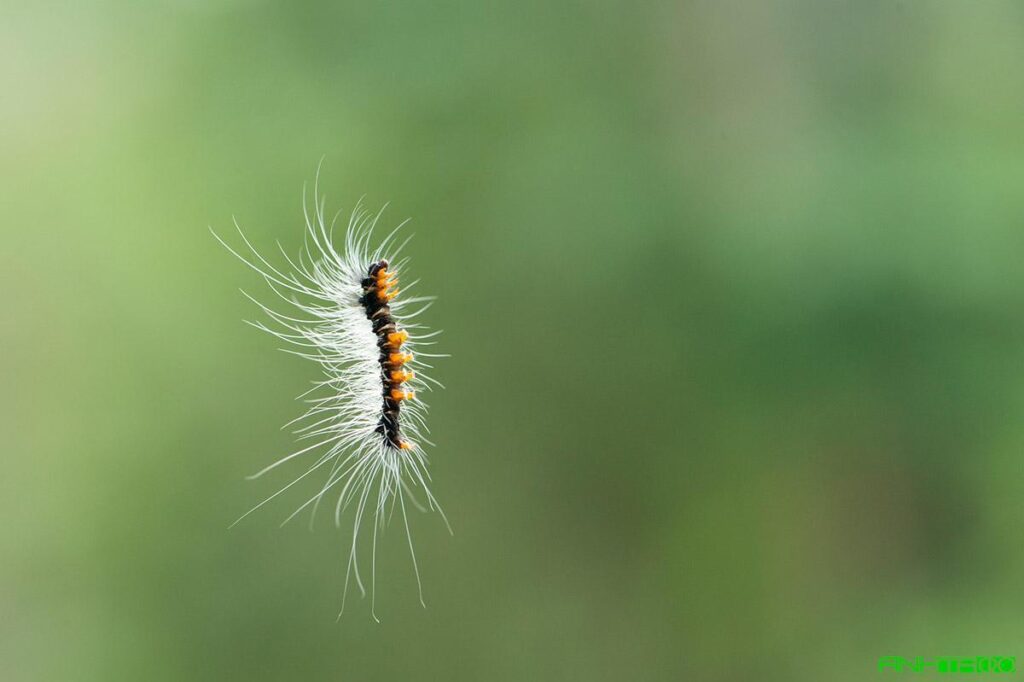
They go by many names! Furry caterpillars, fluffy caterpillars, fuzzy caterpillars, hairy caterpillars, and what not! But no matter what you call them, there is no denying that these woolly creatures are a curious sight. Seeing one of these will undoubtedly give rise to some questions. More often than not, these questions are: What is this woolly worm? Can I touch it?
So, let’s answer that right away! These woolly caterpillars usually turn into moths. You can look at this guide to learn about the types of caterpillars that turn into moths and those that turn into butterflies. Also, you should probably keep your distance and avoid making contact unless you recognize the particular caterpillar species and are aware of the potential risks.
Fuzzy caterpillars come in a variety of sizes and colors. Even within the same species, the colors and size of a fuzzy caterpillar vary depending on its age and environment among many other factors. That is why identifying fuzzy caterpillars is a challenging task. Sometimes even for the trained entomologists, it becomes a bit of a headache.
Online sources usually suggest using the geographic location as well as the number, size, and color of hairs to identify a particular caterpillar species. However, these hairs are often missing as they naturally break off as a part of the caterpillar’s natural defense mechanism.
This article is our attempt at helping you learn about the different types of fuzzy caterpillars and what are some fun facts about them. In addition to that, the article also contains instructions and an identification guide to help you recognize and differentiate between common furry caterpillars and what to do if you see one!
Furry Caterpillar Types, Facts, And Pictures
Before we go ahead and start throwing different types of fuzzy caterpillars at you (not literally!). We just want you to remember that the descriptions and identification guides are designed by keeping mature caterpillars in mind. Furry caterpillars are nothing more than the mature larvae of some moths. These larval stages, after emerging, constantly feed and grow in size.
As already stated, color and size variations are also present in a single caterpillar species. So an immature larval stage might look different from a mature caterpillar. Nonetheless, it is usually the mature hairy caterpillar that could harm you and the one you might want to avoid. So, let’s get started!
1. Garden Tiger Moth Caterpillar
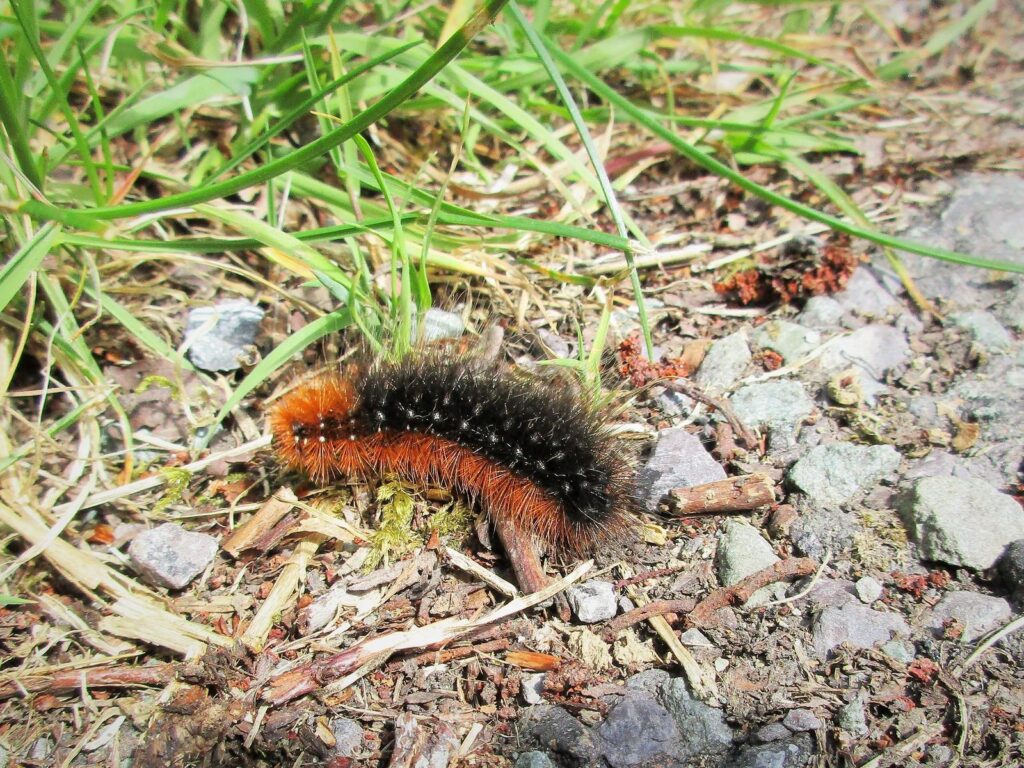
Also known as woolly caterpillars, these larval stages of tiger moths are large and black. They are covered with long, dense hairs that give them a furry look. That is why some people also call the garden tiger moth caterpillar, the woolly bear.
The garden tiger moth caterpillar is well protected against predators, and not just because of its spiny hair. The young caterpillar feeds on a variety of toxic leaves and stores the toxins inside their bodies. This makes them unpalatable to predators which are mostly birds. Also, the spiny hair on their back acts as a deterrent to birds. The hair also provides protection against wasps and parasitic flies.
Garden Tiger Moth Caterpillar Identification Guide And Quick Facts
| Scientific Name | Arctia caja |
| Other Names | Great tiger moth caterpillar |
| Size (Average) | 6 cm when fully grown |
| Color | Black on the upper side, Brown underneath |
| Body Features/Markings | – Long white hair set amongst dense layers of shorter black and ginger hair – Thick white spots on the upper side |
| Hosts | – Generalists, meaning they are not very picky about what they eat- Usually, obtain toxic compounds from foxgloves and fleaworts |
| Range | – Well distributed in much of Britain – Common in England, Scotland, and Wales |
2. Yellow Woolly Bear Caterpillar
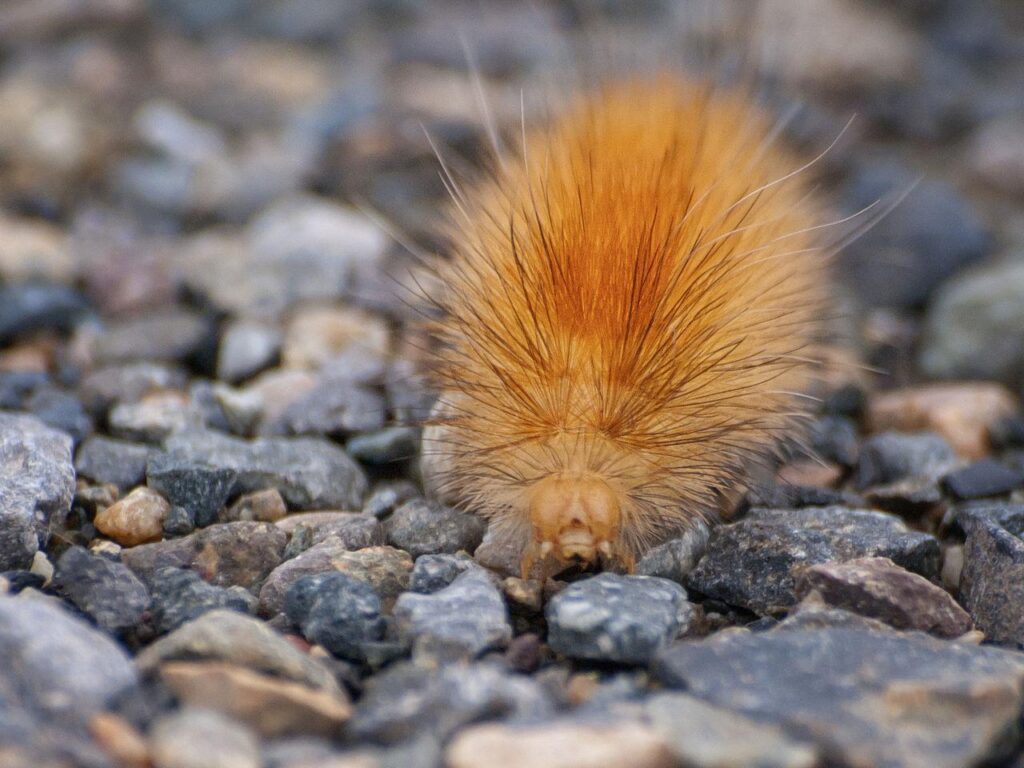
A small yellow hairy caterpillar that is amongst the most common types of fuzzy caterpillars in North America. Due to their diverse feeding habits, yellow wooly bears are present in almost every place where vegetation exists.
Despite what its name suggests, the yellow wooly bear moth caterpillar is not always yellow. It can be any color, from off-white to dark orange. Additionally, yellow woolly bears are very fluffy-looking creatures as they have a lot of yellow tufts arising from all over their bodies.
They are most active during late summer and early autumn. They do not cause any significant damage to plants as they constantly move from plant to plant.
Yellow Woolly Bear Caterpillar Identification Guide And Quick Facts
| Scientific Name | Spilosoma virginica |
| Other Names | Virginia tiger moth caterpillar and Yellow bear caterpillar |
| Size (Average) | Up to 5 cm |
| Color | Usually yellowish but can vary from light brown to orange to nearly white |
| Body Features/Markings | – Densely hairy- Uniform coloring across the body |
| Hosts | – Many common weeds, field crops, and garden plants – Hemp, carrot, asparagus, pea, sweet potato, etc. |
| Range | – Forests and meadows throughout North America – Most common in East Coast |
3. Hickory Tussock Moth Caterpillar
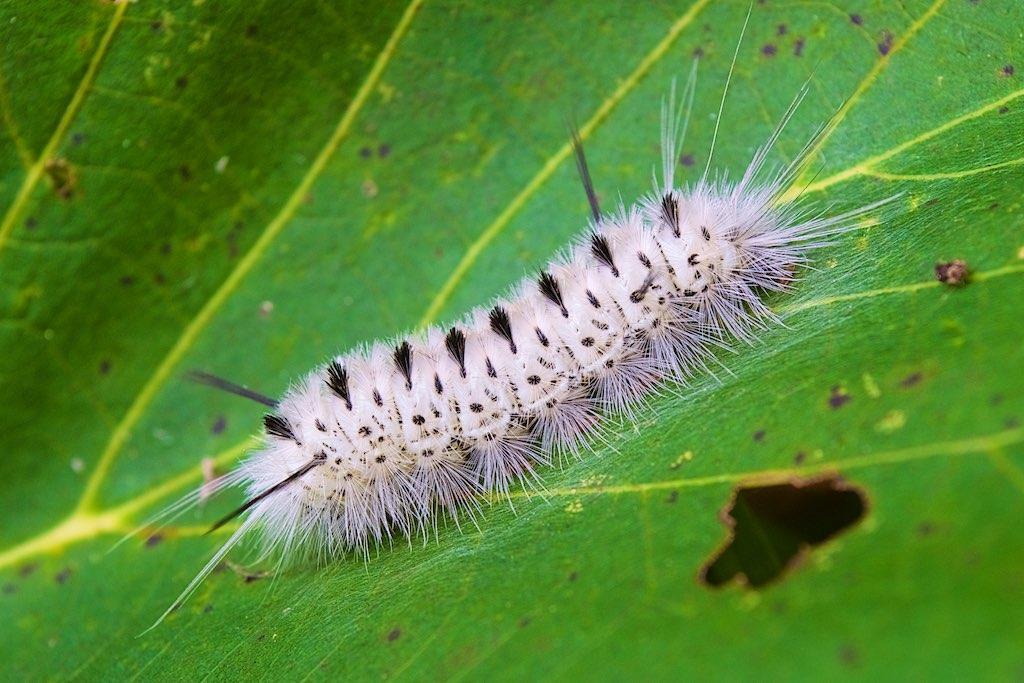
A fluffy white caterpillar that despite looking cute, is venomous. Touching a hickory tussock caterpillar can cause a rash similar to poison ivy. Young hickory tussock caterpillar is somewhat a social creature, feeding in groups of a few. While older caterpillars are primarily solitary and usually feed alone.
They are shy creatures and are often encountered when they are done eating and leave the host plants to find a safe place for making cocoons. Also, while spinning the cocoons, they incorporate their venomous hair into the silk in order to protect themselves. Hickory moth caterpillars rarely cause any significant damage to plants.
Hickory Tussock Moth Caterpillar Identification Guide And Quick Facts
| Scientific Name | Lophocampa caryae |
| Other Names | Hickory tiger moth caterpillar |
| Size (Average) | 4.5 cm |
| Color | Fuzzy white and black |
| Body Features/Markings | – Numerous tufts of white and black hair (setae) – Black warts on the back – One pair of large black bristles on each end |
| Hosts | – Preferred hosts: Hickory, walnuts, pecan, and American hornbeam – Other hosts: Blueberry, rose, sumac, ash, elm, oak, and maple |
| Range | – Primarily in northeastern North America – Less common but present in Texas and Mexico |
4. Southern Flannel Moth Caterpillar

It is one most venomous of all caterpillars that are present in the United States. These hairy caterpillars do not actively attack people. But if you purposely or accidentally come into contact with these furry creatures, their stinging hairs can pierce your skin.
Reactions range from harmless itching to nausea and fever. Also, the southern flannel caterpillar is unique amongst both butterfly caterpillars and moth caterpillars. It has seven pairs of prolegs (fleshy legs on abdominal segments), while all other caterpillars have five or fewer pairs.
The southern flannel caterpillar is also known as the puss moth caterpillar. This might be because they resemble a cat with its soft fur. Their hairs during maturity get so thick that their body is completely hidden from sight.
Southern Flannel Moth Caterpillar Identification Guide And Quick Facts
| Scientific Name | Megalopyge opercularis |
| Other Names | Fire caterpillar, Woolly slug, Asp caterpillar, Opossum Bug, and Perrito |
| Size (Average) | 3.5 to 4 cm |
| Color | Vibrant orange to grayish or beige speckled black |
| Body Features/Markings | – An extremely fluffy orange body- Bright orange streak on sides – Might appear teardrop-shaped- Few patches of whitish hair |
| Hosts | Oak, elm, wild plum, and some garden plants such as ivy and roses |
| Range | – Distributed throughout the Eastern United States |
5. White-Marked Tussock Moth Caterpillar
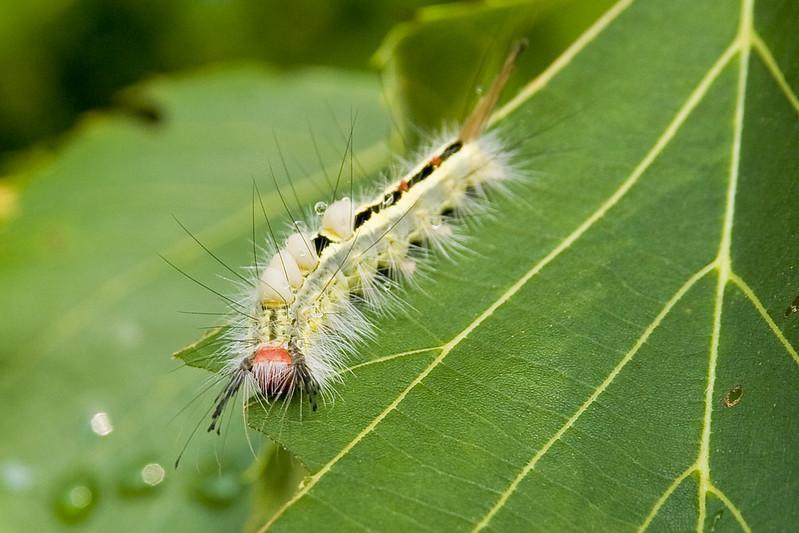
White-Marked Tussock Moth Caterpillar made headlines when the Florida Health Department issued a warning to look out for this particular stinging hairy caterpillar. They are voracious eaters. High populations can completely defoliate small trees in a matter of just a few days.
They have been recorded to eat more than 116 genera of plants. Young white-marked tussock caterpillars feed on soft leaves. In contrast, the mature caterpillars consume entire leaves, leaving only the larger veins behind. Often, plants with poor site conditions or under stress cannot even recover.
Even though the hairs of white-marked caterpillars are not attached to venom glands, they can still cause itching or stinging sensations on contact. Due to their unique exotic looks, these caterpillars are very popular among pet owners. Also, they are not very picky about what they eat. So, it is not hard to raise them!
White-Marked Tussock Moth Caterpillar Identification Guide And Quick Facts
| Scientific Name | Orgyia leucostigma |
| Other Names | – |
| Size (Average) | Up to 3.5 cm |
| Color | Almost all parts of its body have different or mixed colors |
| Body Features/Markings | – Bright red head – Two long black antennae on the head – Tufts of white or gray hair on first abdominal segments – Thick black and yellow stripes along the back – Black and brown bushy tails on rear – Sharp white setae along the sides |
| Hosts | Apple, elm, maple, basswood, oak, pear, poplars, redbud, plums, rose, walnut, willow, sycamore, among many others |
| Range | Eastern North America |
6. Milkweed Tiger Caterpillar
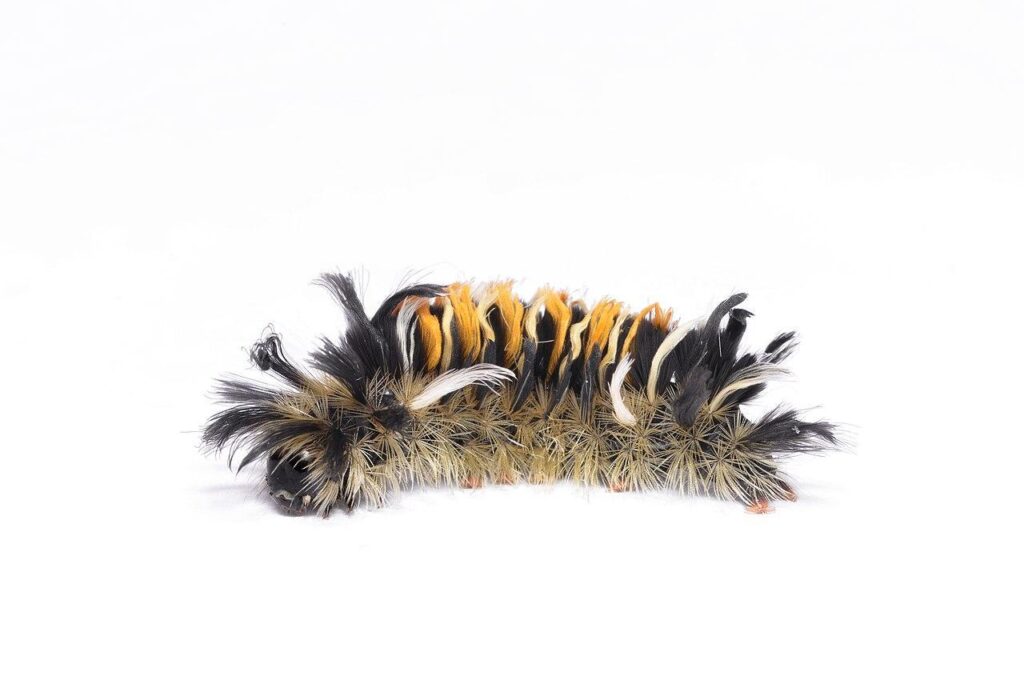
They start their life on milkweed leaves when they just look like off-white shiny head capsules. They feed in large crowds, striping leaves of their tissues while also avoiding leaf veins. The veins contain sticky milkweed secretions that could glue these tiny larvae in their places.
They retain the toxic compounds from milkweed leaves. It makes their bodies bitter and unpalatable to predators. This, together with their voracious appetite, helps them grow quickly. Soon, hairs start emerging from all over their bodies. The caterpillar now starts looking like a bristled end of a toothbrush but somewhat more colorful.
As their name suggests, these furry caterpillars are exotic-looking creatures that only feed on milkweed. The caterpillar, when fully mature, lives a solitary life. It drops to the ground when it senses danger. But do not think it is harmless! These caterpillars can cause significant damage to plants with their big appetites.
Milkweed Tiger Caterpillar Identification Guide And Quick Facts
| Scientific Name | Euchaetes egle |
| Other Names | Milkweed tussock moth caterpillar |
| Size (Average) | Up to 3.5 cm |
| Color | Gray to black with hints of pale orange |
| Body Features/Markings | – Numerous black and orange hairy tufts – Pairs of white tufts on both ends. These are longer than the rest of the hair on the body – Orange markings become more prominent as the caterpillar ages |
| Hosts | Milkweed |
| Range | Texas and Florida in North America to southern parts of Canada |
7. Pale Tussock Moth Caterpillar
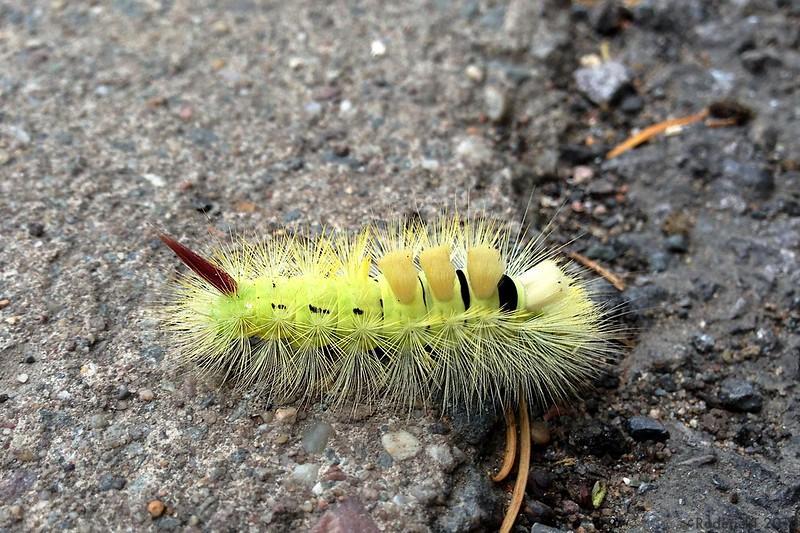
The pale tussock furry caterpillar is large and very visible. Tufts of very fine large hair make it even more noticeable to the naked eye. Sure, these furry caterpillars look stunning, but you should keep your distance. The caterpillar’s spines can cause a nasty itching if contacted.
These furry caterpillars can be seen between late June and early October. They are frequently found in gardens and parks. Sometimes, they can also be found in scrubs, woodlands, and other bushy places.
Unlike literally all other young caterpillars, the young ones of this pale tussock furry caterpillar rather grow slowly. Many of them are not even fully grown until late September. These caterpillars are usually seen in leaf litter, and they overwinter in a cocoon.
Pale Tussock Moth Caterpillar Identification Guide And Quick Facts
| Scientific Name | Calliteara pudibunda |
| Other Names | Hop dogs and pale tussock caterpillar |
| Size (Average) | 4 to 6 cm |
| Color | Pale green or bright yellow |
| Body Features/Markings | Hope, elm, birch, hazel, lime, and oak |
| Hosts | – Off-white to yellow or brown hair – Sometimes, individuals with pink and red hair also exist – Bold black markings on the back – 3 to 4 large tufts on the anterior segments of the body – Pink Brown large single tail tuft |
| Range | Europe and southeastern Russia, Korea, China, and Vietnam |
8. American Dagger Moth Caterpillar
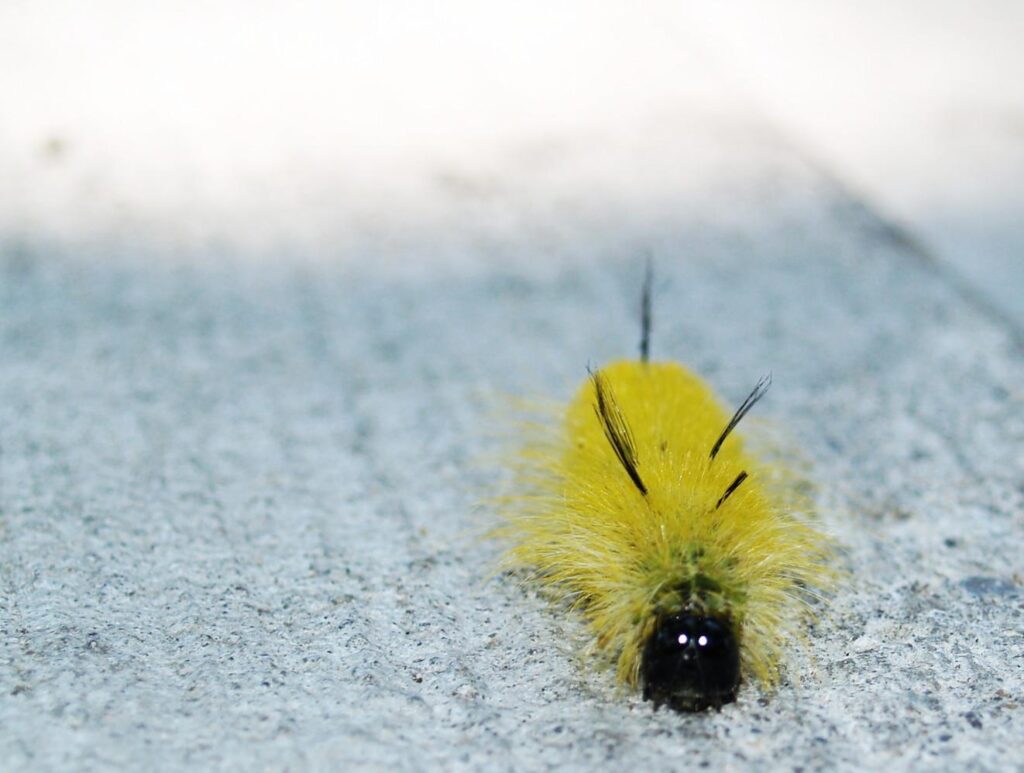
The next furry caterpillar type on our list is the American dagger caterpillar. Sounds menacing, no? Well, there is a good reason for that! The caterpillar has a reputation for teaching children not to touch everything they see. People describe that getting pierced by one of its spines feels like someone stabbed you with a dagger.
The American dagger caterpillar is generally seen in forests and backyards between August and October. They rest on the undersides of leaves with their heads curled on one side. Also, American dagger caterpillars are rarely a reason for significant damage to the plants.
Ric Bessin, an entomologist at the College of Agriculture, University of Kentucky, told a journalist that If these furry caterpillars are in a spot where they can cause problems. You should use a leaf or a stick to relocate it.
American Dagger Moth Caterpillar Identification Guide And Quick Facts
| Scientific Name | Acronicta americana |
| Other Names | – |
| Size (Average) | Up to 5 cm |
| Color | Off white to pale yellow |
| Body Features/Markings | -Soft looking spindly long yellow hair – Shiny black head – 2 pairs of pencil -like long hair near the head – 1 pencil-like long hair towards the rear |
| Hosts | Oak, hickory, ash, birch, elm, maple, oak, willow, walnut, alder, and many other hardwood tree species |
| Range | Eastern parts of North America |
9. Giant Leopard Moth Caterpillar
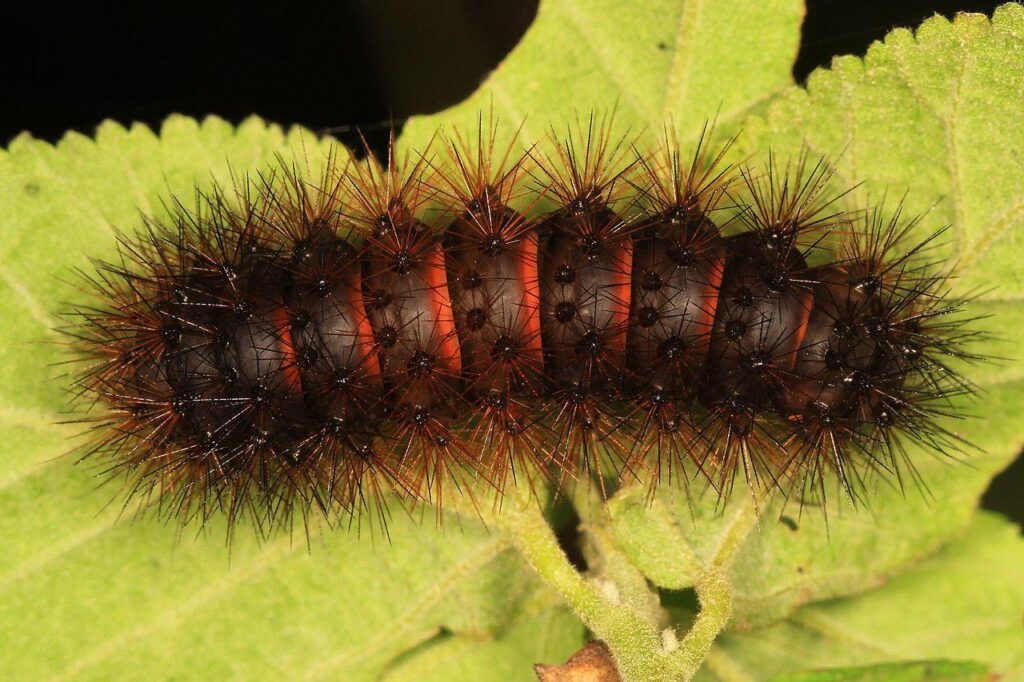
Another woolly bear on our list is the giant leopard moth caterpillar. It is large enough to fit comfortably inside your hands, and its appearance is quite noteworthy. Unlike other woolly bear caterpillars, their bristles are not urticant. It means they do not break off when touched, causing itching or burning.
One interesting fact about these caterpillars is that they do not form cocoons or complete their development until summer. They can produce antifreeze in their blood, allowing them to survive winter without pupating and without a freeze injury.
Although these large caterpillars feed on a number of vegetable and ornamental plants, they rarely occur in significant numbers to cause any severe damage or make treatment necessary.
RELATED: What Do Caterpillars Eat? Top 3 Host Plants You Must Know!
Giant Leopard Moth Caterpillar Identification Guide And Quick Facts
| Scientific Name | Hypercompe scribonia |
| Other Names | Giant woolly bear |
| Size (Average) | Up to 7.5 cm |
| Color | Black with red markings |
| Body Features/Markings | – A thick ring of stiff black setae (hair) on each body segment – Red bands under the furry black coat of setae – The bands become prominent when caterpillars roles into a ball for defense |
| Hosts | Banana, dandelion, cherry, cabbage, maples, orange, violets, sunflowers, and willows among a range of other herbaceous and woody plants |
| Range | – Common in southern and eastern United States – Also present in New England, southern Ontario, Panama, and Mexico |
10. Banded Woolly Bear Caterpillar

According to folklore, banded woolly caterpillars can predict winters. It says that if the reddish-brown portion of their bodies is thin, it will be a harsh winter and vice versa. These furry caterpillars hatch twice a year.
During winters, these furry caterpillars empty their gets and get rid of anything that could make ice crystals. Also, they make antifreeze in their blood which allows them to survive temperatures far below zero.
In fall, these caterpillars seek a winter shelter and form a flimsy cocoon. Then, in spring, they wake back up and start to feed. But this time, when their cocoons hatch, Isabella tiger moths emerge from it. Like the Giant Leopard Moth Caterpillar, Banded woolly bear caterpillars also turn into balls and push their spines out when threatened.
Banded Woolly Bear Caterpillar Identification Guide And Quick Facts
| Scientific Name | Pyrrharctia isabella |
| Other Names | Banded woolly bear, Woolly worm, Isabella tiger moth caterpillar |
| Size (Average) | Up to 6 cm |
| Color | Black and brown |
| Body Features/Markings | – 13 body segments – One brown band surrounded by two dark bands – Stiff hair (setae) on the body |
| Hosts | Dandelion, dock, aster, goldenrod, birches, clover, corn, sunflower, and some types of grass |
| Range | Southern Canada and the United States |
11. Sycamore Tussock Caterpillar
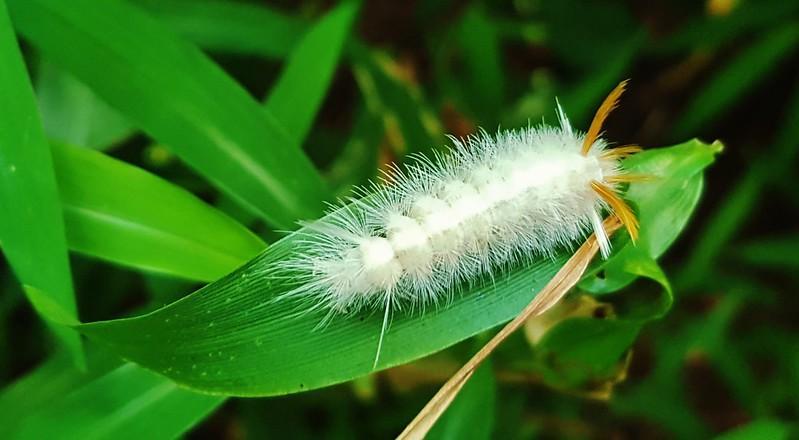
The Sycamore tussock caterpillar is another white caterpillar on our list. It can be often seen dangling from a branch, almost to the ground with a thin silk thread.
Even though these caterpillars have not been reported to sting, they can still irritate human skin. So, it is best if you do not handle them or handle them carefully.
Sycamore caterpillar is definitely unique. The fluffy hair gives it an “old man” look. However, the adult moth is relatively unremarkable and looks pale and dumb.
They only feed on a group of related trees mentioned in the table below. While feeding, they only consume soft parts of the leaves and leave the veins intact.
Sycamore Tussock Caterpillar Identification Guide And Quick Facts
| Scientific Name | Halysidota harrisii |
| Other Names | – |
| Size (Average) | Up to 3 cm |
| Color | Fuzzy white |
| Body Features/Markings | – Light yellow setae covering the whole body – Setae (hair) are longer near the feet – One pair of yellow to orange pencils near the head – One pair of white pencils near orange hair-pencils or near the tail side |
| Hosts | Sycamore leaves |
| Range | Northeast Mexico, eastern parts of the United States, and southeastern Canada |
12. Forest Tent Caterpillars
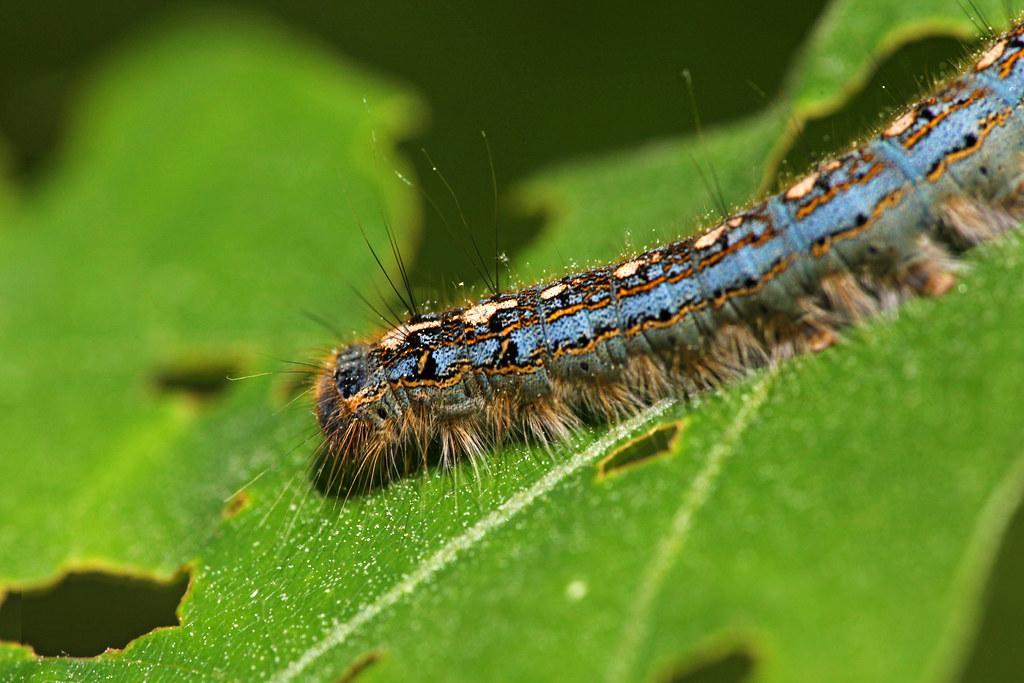
In the areas where they are found, these furry caterpillars significantly reduce the growth rate of deciduous trees. When deciduous trees are completely defoliated, these caterpillars might also move to other nearby plants. Damage from their activity can also be seen on fruits, vegetables, and nursery crops.
Healthy trees can tolerate two or three seasons of consecutive defoliation by these caterpillars. But trees that have become weak due to drought or defoliation stress continuously in consecutive last three or four years usually die.
Not only do they harm plants, but these forest tent caterpillars are also a source of nuisance in the environment too. They do not bite or harm people, but they can make surfaces slippery and greasy if they accidentally get crushed. Also, despite their name, these caterpillars do not make tents like related tent caterpillar species.
Forest Tent Caterpillars Identification Guide and Quick facts
| Scientific Name | Malacosoma disstria |
| Other Names | – |
| Size (Average) | Up to 4.5 cm |
| Color | Mostly blue to black |
| Body Features/Markings | – Blue and yellow stripes on the body – A thick white footprint shaped marking on each body segment – Numerous hair along the edge of the body |
| Hosts | Various species of oaks, gums as well as plum, aspen, basswood, cherry, rose, citrus, pine, etc. |
| Range | Southern Canada and most of the United States |
13. Salt Marsh Caterpillar
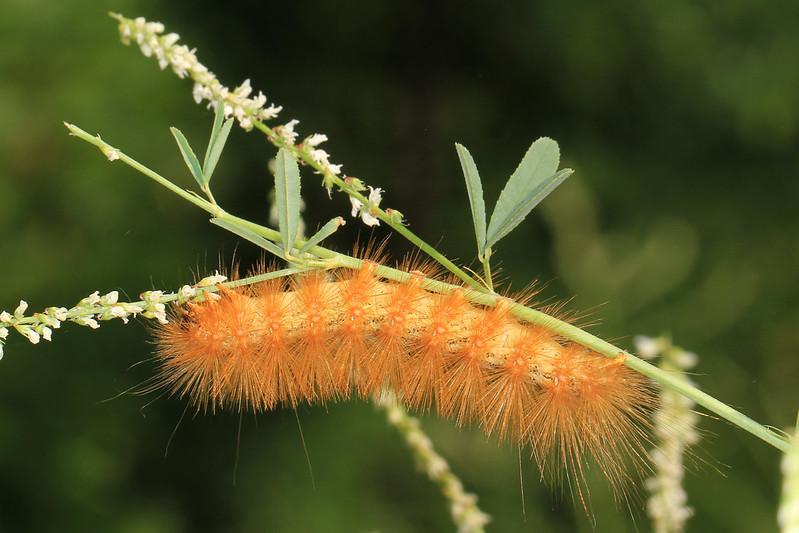
They get their name from their presence in gardens of New England settlers that were located in salt marsh areas. Populations of salt marsh caterpillars are typically seen between late summer and early autumn. During these times, they are most frequently seen on hemp.
These caterpillars are encountered on many plants, but severe damage to any crop is rare. While young, these caterpillars usually eat in groups, but they become solitary as they grow. Salt marsh caterpillar survives winter as a fully grown caterpillar encased in a cocoon that is hidden in leaf litter or other debris on the soil.
Salt Marsh Caterpillar Identification Guide And Quick Facts
| Scientific Name | Estigmene acrea |
| Other Names | Yellow woolly bear saltmarsh caterpillar |
| Size (Average) | 5.5 cm |
| Color | Predominantly yellow, but body-color darkens as they age |
| Body Features/Markings | -Short to medium bristles on the body – Bristles are soft – Tiny black spots between the bristles of segments |
| Hosts | Asparagus, bean, cabbage, carrot, beet, celery, corn, onion, pea, lettuce, tomato, turnip, etc. |
| Range | Central America, the United States, and Canada |
14. Drinker Moth Caterpillar
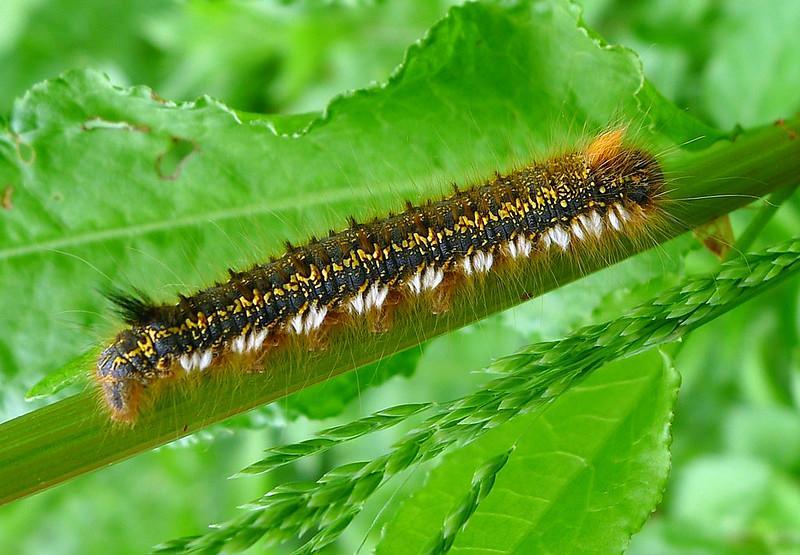
This fuzzy caterpillar gets the word “drinker” in its name because of its behavior of drinking dew drops from grass stems. Eastern tent caterpillars are found in places where the grass is present. But mostly, they prefer moist, damp, and marshy areas. The hair on its body can cause severe itching if touched.
The drinker moth caterpillar spends most of the day resting on the grass and only comes out at night to feed. The populations of these caterpillars suffered greatly during the last century due to parasitoid flies and wasps. But populations have now shown an encouraging recovery in recent years.
Drinker Moth Caterpillar Identification Guide And Quick Facts
| Scientific Name | Euthrix potatoria |
| Other Names | Drinker caterpillar |
| Size (Average) | Up to 7.5 cm |
| Color | Brown and gray |
| Body Features/Markings | – A grainy yellow stripe on the back – Fluffy thick white tufts of hair along the sides – Longer setae at both ends of the body |
| Hosts | Various deciduous trees, including maple and sycamore |
| Range | – Southeastern England – Scattered populations throughout Europe |
15. Eastern Tent Caterpillar
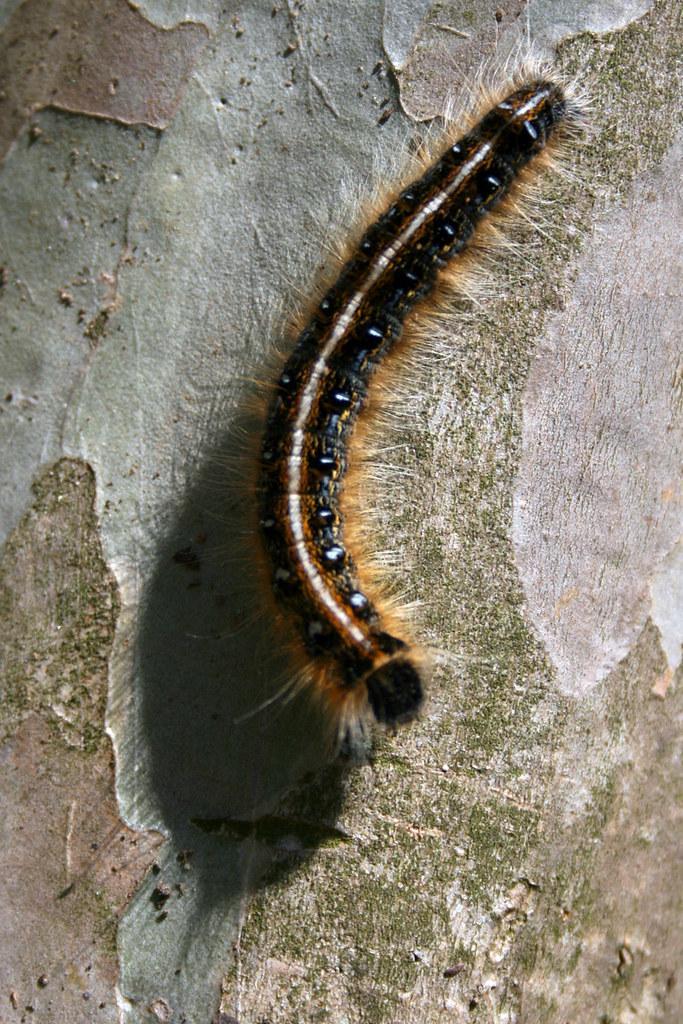
Eastern Tent Caterpillar is a pest endemic to North America. The populations of this fuzzy caterpillar vary from year to year, and there is an outbreak nearly every several years later. Not only do these caterpillars cause harm to plants, but they are also a significant nuisance to the environment.
This fuzzy caterpillar builds silken nests in trees, crawls over walkways, roads, and streets which are all very unsightly scenes in general. They are most common during late spring and early summer.
But keep in mind that these caterpillars do not cause any other damage other than causing temporary harm to plants. They get the word “tent ” in their names because they build communal nests in tree branches that look like tents.
Eastern Tent Caterpillar Identification Guide And Quick Facts
| Scientific Name | Malacosoma americanum |
| Other Names | – |
| Size (Average) | Up to 6 cm |
| Color | Furry black |
| Body Features/Markings | – A distinct white stripe on the back – Blue dots on the side – Silvery white to light brown setae – White spots alongside the white stripe on the back |
| Hosts | Apple, cherry, crabapple, and other plants of the rose family |
| Range | Northeastern United States |
16. Western Tent Caterpillar

The western tent caterpillar is a pest of shrubs and broadleaf trees throughout much of southern Canada, parts of Mexico, and the western United States. The feeding damages typically occur between May and June. The caterpillar looks very much similar to the eastern tent caterpillar, but the latter has a distinct white or yellow stripe on its back.
These caterpillars are gregarious, which means they can make social relationships with each other. That is why they spend a large part of their lives with other caterpillars in silken nets (tents). They only come out of these tents at night to feed.
Western Tent Caterpillar Identification Guide And Quick Facts
| Scientific Name | Malacosoma californicum |
| Other Names | – |
| Size (Average) | 4 to 5 cm |
| Color | Black or whitish gray |
| Body Features/Markings | – Pale blue head – Orange or dark yellow spines on the body – Whitish blue dashes across the back |
| Hosts | Aspen, crabapple, poplar, and willow, among other broadleaf trees and shrubs |
| Range | Southern Canada, parts of Mexico, and the western United States |
17. Io Caterpillar
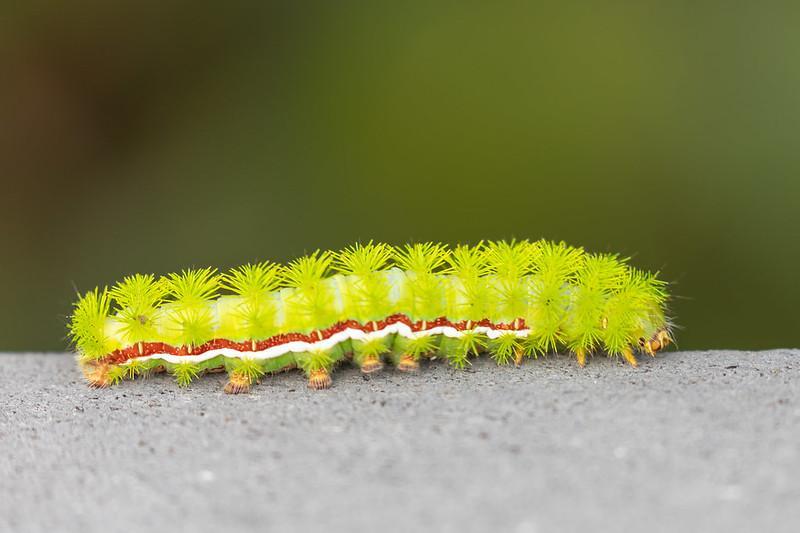
The Io caterpillar ranks first among the list of problematic caterpillars that can cause skin irritation. Spines covering their body are connected with venom glands underneath which get triggered at the slightest touch. So, you should better keep your distance.
The Io caterpillar can be found in a range of habitats, including deciduous woodlands, forests, agricultural orchards, parks, and backyards.
RELATED: Types of Green Caterpillars with Fun Facts, Stunning Pictures and Loads More!!!
Identification Guide And Quick Facts
| Scientific Name | Automeris io |
| Other Names | Peacock moth caterpillar |
| Size (Average) | Up to 7 cm |
| Color | White and bright green |
| Body Features/Markings | – White and red stripes run on the sides – Tufts of bright green hair across all the body |
| Hosts | Oak, willow, hackberry, currant, and various wild cherries |
| Range | Southern Canada to the eastern United States and Mexico |
Frequently Asked Questions (FAQs)
What Is The Name Of A Hairy Caterpillar?
There are several types of hairy caterpillars that go by many names, including fluffy caterpillars and fuzzy caterpillars. Other than the caterpillars mentioned above, there are numerous other species of hairy caterpillars as well. For example, Fox moth caterpillar, Oak eggar moth caterpillar, White ermine moth caterpillar, Lackey moth caterpillar, Buck moth caterpillar, and European gypsy caterpillar.
Are Hairy Caterpillars Poisonous?
Hairy caterpillars are among the most venomous types of caterpillars. Some of these caterpillars have hairy spines that are connected underneath with venom glands. If touched, the spines can break off and pierce the skin. This can cause skin irritability, fever, and in extreme cases, nausea.
Are Hairy Caterpillars Poisonous To Dogs?
According to the ASPCA Animal Poison Control Center, hairy caterpillars can be poisonous to dogs. Some of them feed on plants that contain toxic compounds such as alkaloids which can cause vomiting and diarrhea in pets.
Which Fuzzy Caterpillars Are Poisonous?
You cannot tell unless you know exactly what species you are talking about. But in general, you should avoid caterpillars with bright showy colors. These bright colors act as warning signs, and the brighter the color, the more toxic a caterpillar is. Also, it would be best if you avoided caterpillars with sharp spines or stiff hair as these hairs could break off and pierce your skin.
What Is The Deadliest Caterpillar?
The most dangerous caterpillar in the world is the Assassin caterpillar (Lonomia obliqua). This species is responsible for the death of a few every year. The Guinness Book of World Records has also classified it as the most venomous caterpillar in the world.
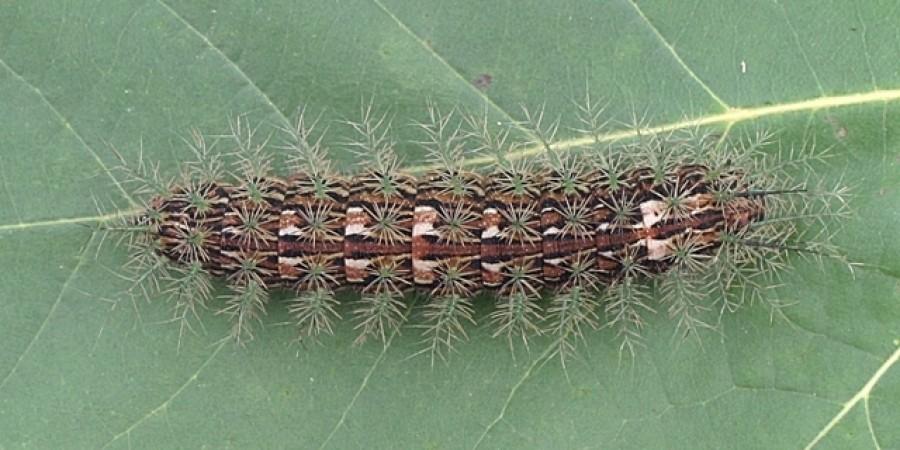
How Do You Get Rid Of A Caterpillar Infestation?
You can start by regularly visiting your garden and plucking any caterpillars by hand. Use protective gloves as some caterpillars can sting. Drop them in a bucket of soap water and then dispose of them off. If the infestation is too strong, you can use a pesticide spray or call for professional help.
What Happens If I Touch A Fuzzy Caterpillar?
Although most hairy caterpillars are harmless, their spines can still cause itching, burning, or trigger an allergic reaction. Some of the nasty ones can also cause fever and nausea. So, make sure you know your caterpillar types before you go ahead and pick one up!
Sources For Further Reading
- Fuzzy fall visitors: Caterpillars that attract attention and could cause needless concern. (2020). Retrieved 19 March 2022, from https://www.canr.msu.edu/news/fuzzy_fall_visitors_caterpillars_that_attract_attention_and_could_cause_nee
- Fuzzy Fall Caterpillars (Family Erebidae) – Field Station. (2012). Retrieved 19 March 2022, from https://uwm.edu/field-station/fuzzy-fall-caterpillars/
- Be Careful with Fuzzy and Hairy Caterpillars! | Blogs | Discovery Place Nature in Charlotte, NC. (2016). Retrieved 19 March 2022, from https://nature.discoveryplace.org/blog/be-careful-with-fuzzy-and-hairy-caterpillars
Now that you learn about the types of furry caterpillars, also read our other plant bug articles:
Types of White Spiders – A Complete Identification Guide, Fun Facts and more
How to Get Rid of Wireworms Effectively?
Common Types of Houseplant Bugs: Who They are & How to Get Rid of Them?







